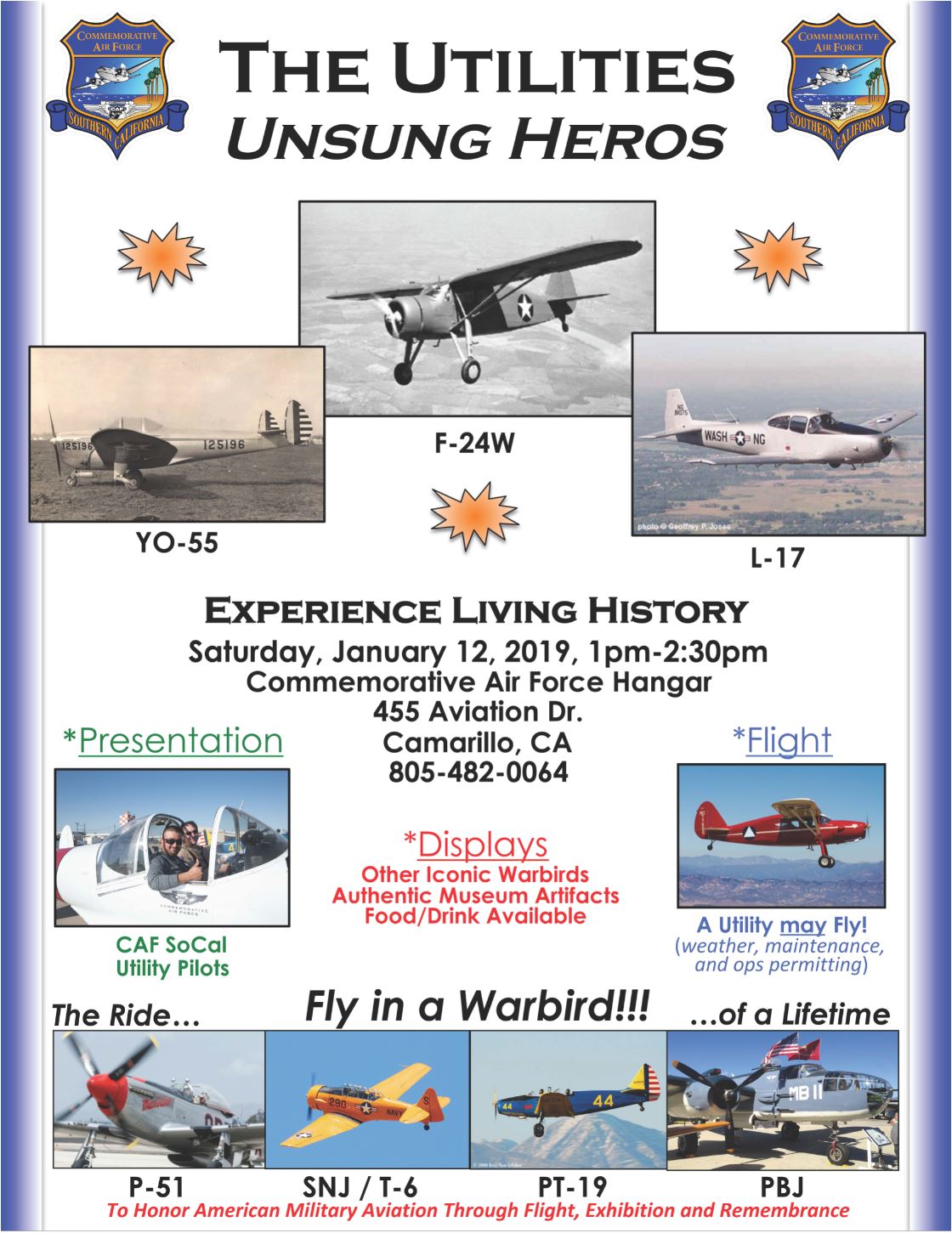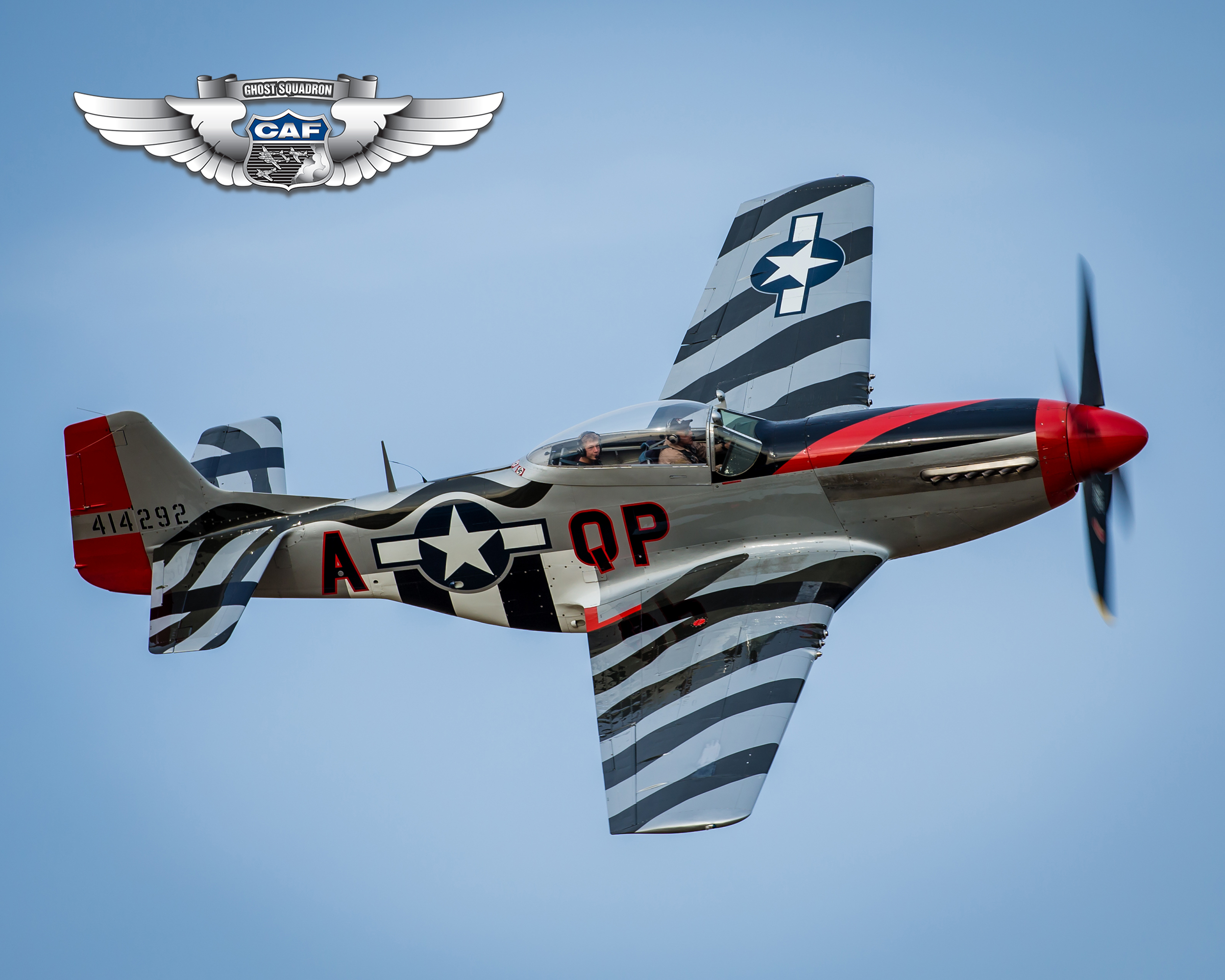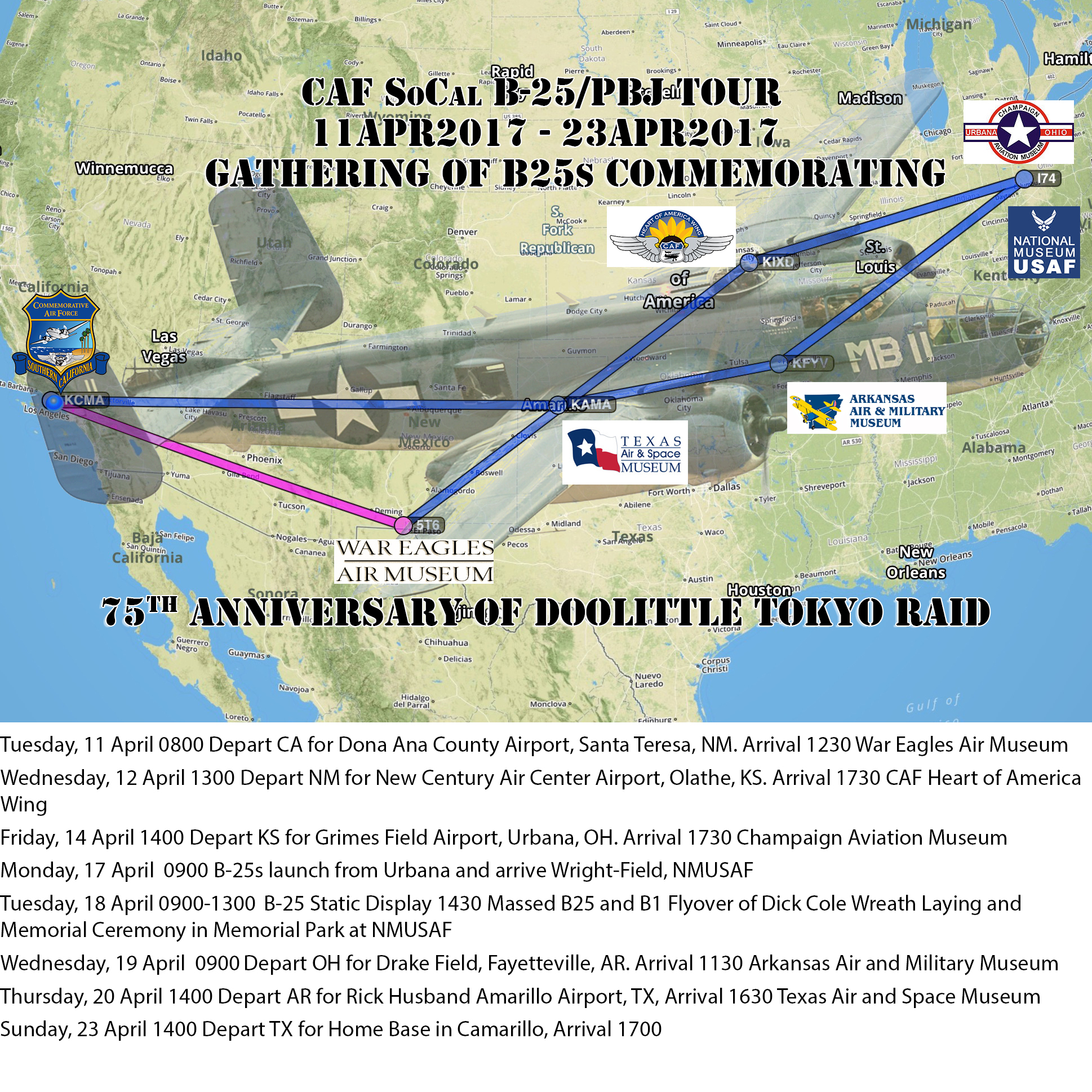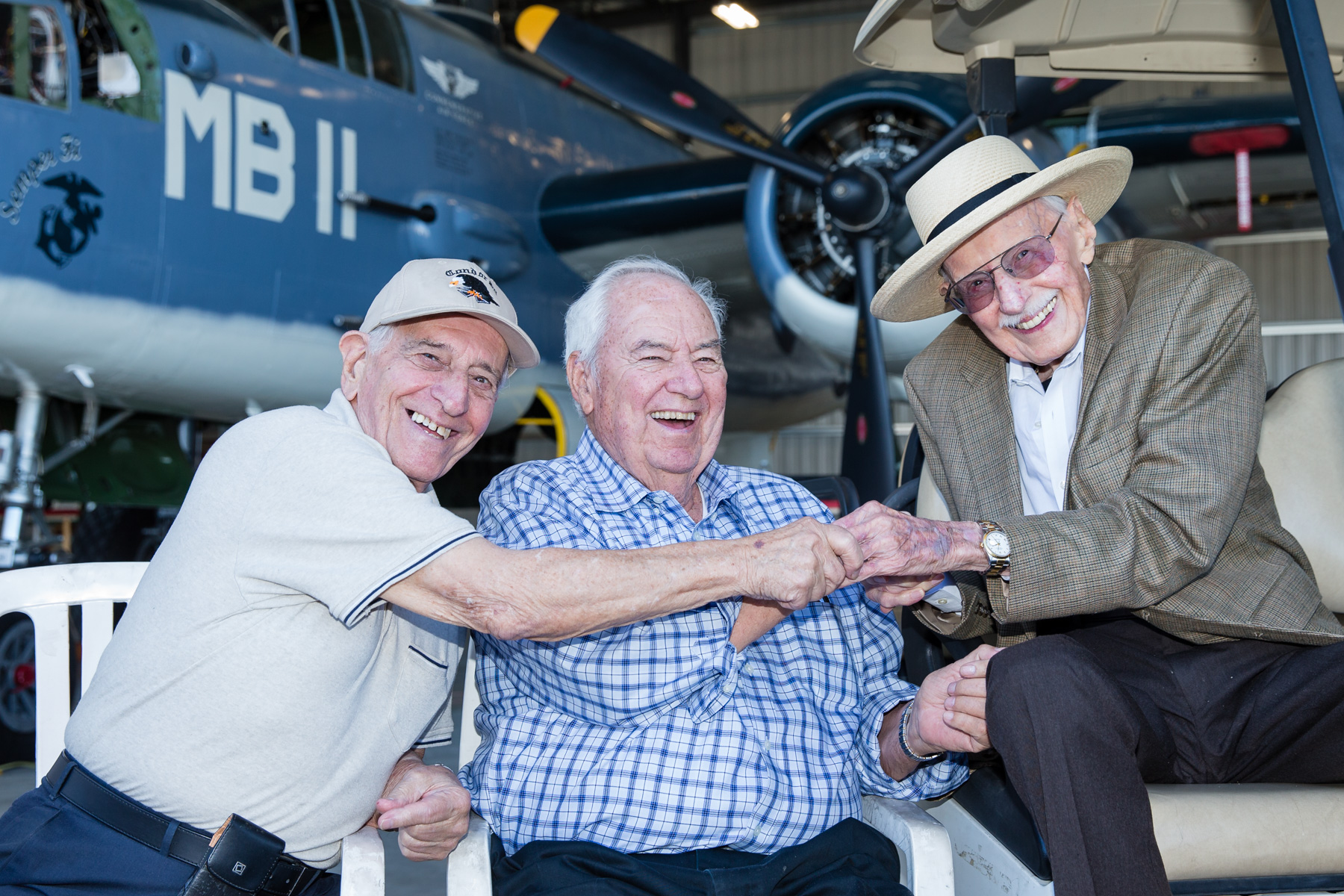Sale in the Gift Shop
To celebrate the happy holiday season, we are offering a 10% off discount in the PX (gift shop) – online orders only, shop now so we can ship quickly!
Use the code: px2021 at checkout to receive your online discount
To celebrate the happy holiday season, we are offering a 10% off discount in the PX (gift shop) – online orders only, shop now so we can ship quickly!
Use the code: px2021 at checkout to receive your online discount
The unsung hero aircraft of World War Two.
Join us for a presentation showcasing the impact of the utility aircraft in the war effort and their usage after the hostilities.
Focused on our three utility aircraft, the Navion, F24 Forwarder and Aircoupe.
The presentation will be followed by a Q&A session at the aircraft and an opportunity sit in the cockpit of these aircraft and get a pilot’s eye view of the instrumentation.
Saturday, January 12, 2019
1PM- 3PM
CAF SoCal hangars at the Camarillo airport

Due to a change of plans, the Museum will be open November 10th. We will be open during normal business hours which are 10 am to 4 pm. Hope to see you there.
The Trainers presentation video is posted below.
The presentation was one of our best attended in the series.
Don’t miss the next one:
Living History Presentation:
Pacific Air War
June 9, 2018
11AM-2PM
CAF SoCal Hangars at Camarillo Airport
On Saturday April 14th, CAF SoCal hosted an event focused on the PT-19 Cornell and including several other pivotal military trainers from the WWII era. We had a group of our pilots talk about their training experiences in the PT-17 Stearman, the PT-19 Cornell, and the AT-6/SNJ Texan and our unit Historian, Ron Fleishmann, outlined the history of CAF SoCal’s Fairchild PT-19 Cornell.
We will be selling P-51 Rides at the Minden Air Show October 8-10. Check our rides section to purchase and schedule your “bucket list” ride.
CAF SoCal museum and hangars will be closed on for the Holiday weekend starting Sunday July 2nd through Tuesday July 4th
Normal operation hours will resume on Wednesday, July 5th.
We wish all our supporters a happy and safe Fourth of July.
Following a meticulous refresh on Man’O’War which included a complete overhaul of the Merlin engine and the propeller, our beautiful two-seater P-51DMustang is back flying!

Expect to see her at the Truckee Airshow and of course our own Wings Over Camarillo Airshow – but don’t wait to book a ride aboard this icon of the skies, her dance card is getting filled fast!
The PBJ will be part of seventeen B-25 Mitchell bombers from around the country appearing at the National Museum of the U.S. Air Force to commemorate the 75th Anniversary of the Doolittle Tokyo Raid. (LINK to news NMUSAF news release.)
Departing on April 11 and returning on the 23rd, the PBJ will make multiple stops along the way at the locations listed below, where the aircraft will be available to tour and for warbird ride experience to the public.
Rides can be purchased from our rides page, except at the Grimes field in Ohio
For questions and reservations for B-25/PBJ rides on this tour, please call:
805-603-9910

Among the museums artifacts on display is the center section of the wind tunnel model for the XCG-16 Bowlus Transport Glider.

The artifact was donated to the museum by Hal Huber, a friend of the museum, former Air Traffic Controller, and a nephew of Mr. Bowlus.
The XCG-16A was the result of a 1942 US Army requirement for a glider capable of carrying a load of up to four tons of cargo (approx. 42 equipped troops). The all-wood twin boom military transport glider of 91ft 10in span, featuring an airfoil-sectioned lifting-body fuselage between the booms in which either cargo or troops could be carried in two 16ft x 7ft compartments. A single fin and rudder was mounted on the tail plane between the booms and the aircraft featured retractable tricycle landing gear and flaps.
The unconventional design allowed for the front of the wing to open upwards and downwards for quick loading and off-loading of troops and materiel. The crew of two sat in tandem beneath a continuous canopy atop the center section.
Ultimately unsuccessful, this glider had the potential to make significant impact on the upcoming invasion of mainland Europe.
In the following image, the XCG-16 can be seen on the runway of what used to be Oxnard Flight Strip (later to become Oxnard Air Force Base in 1952 and currently Camarillo airport), as evidenced by the hill in the background which is locally referred to as “round mountain” and serves as a navigation guide even today.

The XCG-16 was an interesting departure from the single-fuselage design which had been common to American gliders. It also introduced the twin boom. In it the trend towards better aerodynamic characteristics for transport gliders could be seen that was to reach its apogee in the XG-20, a post-war development. It is worth noting that the XCG-16 had some of the same aerodynamic design elements as the German Mammut.The story of its development is extraordinary. In February 1942 William Hawley Bowlus of Bowlus Sailplanes began the design and construction of a flying wing glider. A half-size prototype of the glider was completed later that year, and in October, Mr. Bowlus and an associate, Mr. Albert Criz, began a campaign to secure a government contract. They organized the Airborne Transport Company in Los Angeles, California, which fnally became the General Airborne Transport Company.An inspection of Airborne Transport’s facilities, disclosed that the ‘factory’ was a small store building formerly used as a dry cleaning shop; just large enough for the half-sized glider they had constructed to be fitted into the building sideways.Next, the Company launched into the construction of a full-scale model, looking for support in Washington. They were stimulated by self deception, or possible political support, into the belief that a contract for 1,000 of their gliders was in the offing.After completing the glider, Airborne Transport Company offered it to Wright Field for test and evaluation. Meanwhile the company conducted its own tests. On II September 1943 Richard duPont, the glider specialist on the staff of the Chief of Staff of the Air Force, and Colonel Ernest Gabel of the same office were killed when the MC-I crashed at March Field, California. Mr. Bowlus, without authority from military officials, had arranged for a test fight. The glider took off with some passengers, and loaded with bags of lead shot or sand to bring the load up to capacity. Unfortunately no one had the forethought to lash in the dead weight bags, and they shifted in the turbulence. The glider began ‘porpoising’, endangering the tow-
plane. The tow-plane’s pilot cut the MC-I loose. By this time the glider was so off balance that it was uncontrollable, and went into a dive. Mr Bowlus and one other passenger managed to parachute to safety. All others were killed.This tragedy did not deter the company, and a contract was approved on 13 November. They finally delivered one glider, some six months later than promised and at three times the original cost estimate. This glider became the XCG-16.
It was a high swing, cantilever monoplane with twin booms to support the empennage. Unique from an aerodynamic standpoint was the airfoil-shaped fuselage between the booms, looking much like the Brunelli aeroplane introduced in the early 1930s. The front of the wing on each side of the loading nacelle opened like a jaw, the top swinging about horizontal hinges along the leading edge of the airfoil, the bottom swinging on hinges on the bottom of the fuselage to rest on the ground and form a loading ramp. The glider had dual and the pilots sat in tandem. Landing gear was retractable. The outer wing panels had slotted wing-flaps, and the centre section of the fuselage also had a split flap. The flaps were actuated by electrical power. The glider was constructed largely of plywood; movable surfaces, such as flaps, were covered with fabric. Because the cargo area tapered to zero at the rear, the seats at the rear of the fuselage allowed little headroom for passengers.The glider was tested at the Clinton Army Air Field and at Orlando, Florida, by the AAF Board. It concluded that the glider had inadequate crash protection, unsatisfactory loading ramps, insufficient personnel exits, awkward location of flight equipment, critical lateral loading and restricted pilot visibility. The contract was terminated on 30th November 1944.
Technical Data
Glider Model: XCG-16
Upe: transport glider
Crew: pilot, co-pilotDimensions
Wing-span: 91.8ft
Wing area: 1140sq ft
Fuselage
Length: 48.3ft
Height: 18.3ft
Cargo compartment
Length: 15ft
Width: 7ft
Height: 5ftWeight
Total with cargo: 19,580lb
Empty: 9,500lb
Cargo: 10,0801bLoading:
Two M2 105 mm howitzers; or one M2 105 mm
howitzer, and one 1/4-ton 4X4 truck with gun crew; or 42 troops, equipped.Flight performance
Maximum airspeed: 220mph
Maximum airspeed with flaps: 120mph
Stalling speed
Flaps up: 62mph
Flaps down: 58mph
Aspect ratio: 7.4
Tow-planes: C-47, C-46, C-60
We are lucky to have in our collection this artifact and the accompanying historic footage of the glider’s test flights which is presented here and on our YouTube channel:
Technical plans for the glider:
It is with great sadness that we announce the passing of Bob Hoover, one of aviation’s greatest pilots. A legendary aviator and a gracious gentleman, he will be sorely missed and fondly remembered by all who knew him.

Sy Robins, Clay Lacy and Bob Hoover visiting CAFSoCal in 2016
Our condolences go out to Bob’s Family